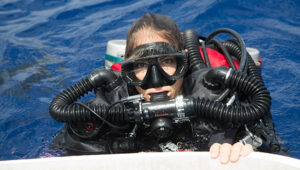Nekton Mission Launches in Bermuda

BIOS reef ecologist Gretchen Goodbody-Gringley was one of several local scientists participating in the Nekton project. Photo by Ron Foth Jr.
If you have ever watched a documentary about deep ocean exploration, you have probably heard that “95 percent of the ocean floor is unexplored.” In fact, we do have a global map of the ocean floor generated by satellite data that allows us to see features on the ocean floor larger than 3 miles (5 kilometers) in length. Missing from this picture, however, are the geologic features smaller than this size, not to mention millions of plants and animals inhabiting the deep ocean and seafloor.
It is at this scale that a new global research project—called Nekton—is focusing its efforts, bringing together a suite of ships, dive boats, submersibles, remotely operated vehicles (ROVs), technical divers, and scientists to explore the deep ocean and, both figuratively and literally, bring their findings to light.
With a public event held at the Bermuda Underwater Exploration Institute (BUEI) on July 19, the Nekton team officially launched its first mission, sponsored by the XL Catlin Deep Ocean Survey, in Bermuda. During the next two weeks, and with partners from the Florida-based conservation group Project Baseline and BIOS, Nekton took to the waters around Bermuda to obtain video footage, retrieve biological and seawater samples, and conduct visual surveys of deep water reef ecosystems.
BIOS reef ecologist Gretchen Goodbody-Gringley was one of several local scientists participating in the Nekton project. She used the opportunity to not only support Nekton’s research, but to conduct research of her own focusing on the genetic connectivity and reproductive capacity of deep corals. By comparing samples of corals from different depths, Goodbody-Gringley hopes to better understand how deep coral communities are impacted by changing ocean conditions.
“Working with the Nekton group enabled access to depth ranges beyond my current capabilities, thereby expanding the scope of my research program,” she said.
In her other role researching lionfish ecology, Goodbody-Gringley also used the deep dives to conduct visual lionfish surveys and collect biological samples. She clipped fins for studies on population genetics, sampled reproductive organs to assess fertility and maturity, and used genetic barcoding to identify the contents of the lionfish stomachs, information that helps scientists learn what these invasive fish are eating and in what quantity.
While Nekton has officially completed its first mission in Bermuda, Goodbody-Gringley’s work has just begun as she analyzes her samples and field surveys. She described her experience with Nekton as a “win-win,” adding that “collaborations like this are essential to answering many of the pressing questions we have about the ocean, as they allow scientists to leverage resources and equipment.”
